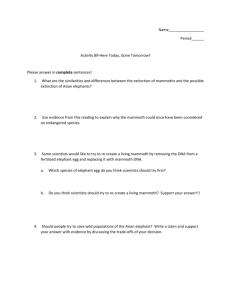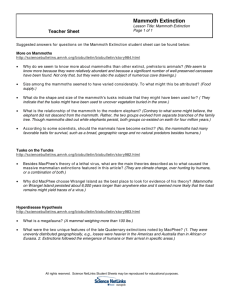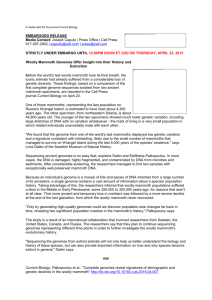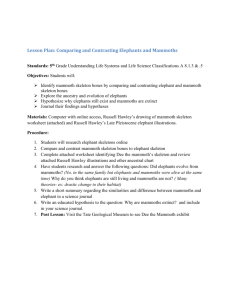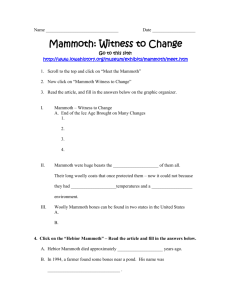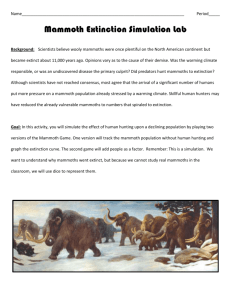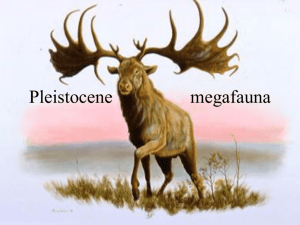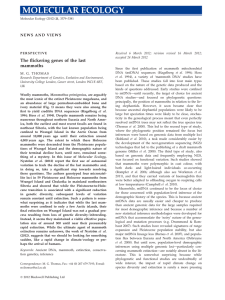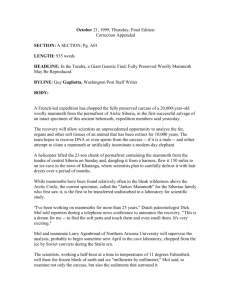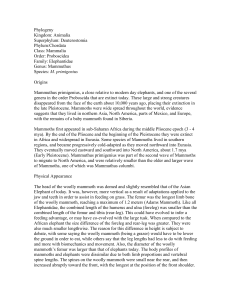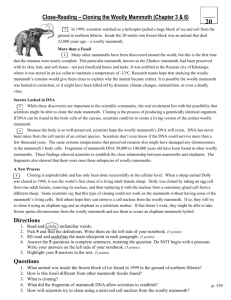2015年10月8日雅思阅读机经 Passage One 新旧情况:新 文章类型
advertisement
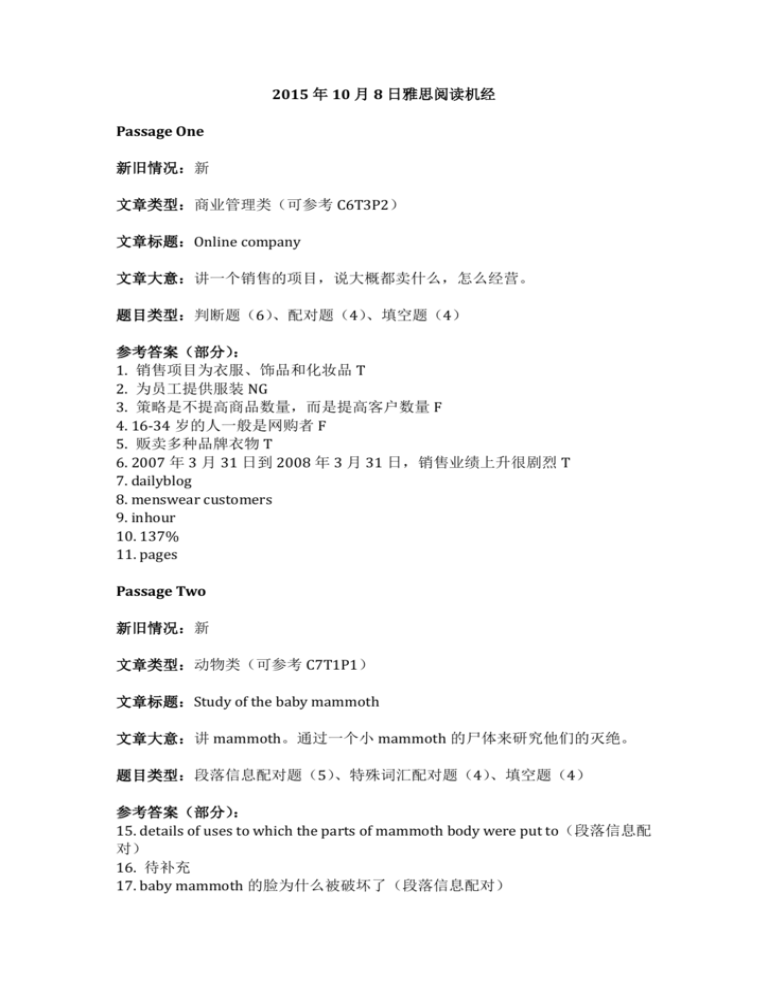
2015 年 10 月 8 日雅思阅读机经 Passage One 新旧情况:新 文章类型:商业管理类(可参考 C6T3P2) 文章标题:Online company 文章大意:讲一个销售的项目,说大概都卖什么,怎么经营。 题目类型:判断题(6) 、配对题(4)、填空题(4) 参考答案(部分): 1. 销售项目为衣服、饰品和化妆品 T 2. 为员工提供服装 NG 3. 策略是不提高商品数量,而是提高客户数量 F 4. 16-34 岁的人一般是网购者 F 5. 贩卖多种品牌衣物 T 6. 2007 年 3 月 31 日到 2008 年 3 月 31 日,销售业绩上升很剧烈 T 7. dailyblog 8. menswear customers 9. inhour 10. 137% 11. pages Passage Two 新旧情况:新 文章类型:动物类(可参考 C7T1P1) 文章标题:Study of the baby mammoth 文章大意:讲 mammoth。通过一个小 mammoth 的尸体来研究他们的灭绝。 题目类型:段落信息配对题(5)、特殊词汇配对题(4)、填空题(4) 参考答案(部分): 15. details of uses to which the parts of mammoth body were put to(段落信息配 对) 16. 待补充 17. baby mammoth 的脸为什么被破坏了(段落信息配对) 18. similarities of relevant studies on mammoth in different places of the world (段落信息配对) 19. an explanation or theory on why mammoth died out(段落信息配对) 20. vegetarian 21. human hunting 22. 待补充 23. 待补充 24. 它是相对保存最好的尸体(特殊词汇配对) 25. 猛犸象牙齿说是谁提出的(特殊词汇配对) 26. 温度骤降说导致猛犸象灭绝(特殊词汇配对) 27. 待补充 相关阅读: Mammoth is any species of the extinct genus Mammuthus,proboscideans commonly equipped with long,curved tusks and, in northern species,a covering of long hair. They lived from the Pliocene epoch from around 5 million years ago,into the Holocene at about 4 , 500 years ago. and were members of the family Elephantidae,which contains,along with mammoths,the two genera of modern elephants and their ancestors. Like their modem relatives, mammoths were quite large. The largest known species reached heights in the region of 4 m at the shoulder and weights up to 8 tonnes, while exceptionally large males may have exceeded 12 tonnes. However, most species of mammoth were only about as large as a modem Asian elephant. Both sexes bore tusks. A first, small set appeared at about the age of six months and these were replaced at about 18 months by the permanent set. Growth of the permanent set was at a rate of about 1 to 6 inches per year. Based on studies of their close relatives, the modem elephants, mammoths probably had a gestation period of 22 months, resulting in a single calf being bom. Their social structure was probably the same as that of African and Asian elephants, with females living in herds headed by a matriarch, whilst bulls lived solitary lives or formed loose groups after sexual maturity. MEXICO CITY—Although it’s hard to imagine in this age of urban sprawl andautomobiles, North America once belonged to mammoths, camels, ground sloths aslarge as cows, bear-size beavers and other formidablebeasts. Some 11,000 years ago, however, theselargebodied mammalsand others—about 70species in all——disappeared. Their demisecoincided roughly with the arrival of humans inthe New World and dramatic climatic change—factors that have inspired several theories aboutthe die-off. Yet despite decades of scientific investigation, the exact cause remains a mystery. Now new findings offer support to one of these controversial hypotheses: that human hunting drove this megafaunal menagerie to extinction. The overkill model emerged in the 1960s, when it was put forth by Paul S. Martin of the University of Arizona. Since then, critics have charged that no evidence exists to support the idea that the first Americans hunted to the extent necessary to cause these extinctions. But at the annual meeting of the Society of Vertebrate Paleontology in Mexico City last October, paleoecologist John Alroy of the University of California at Santa Barbara argued that, in fact, hunting- driven extinction is not only plausible, it was unavoidable. He has determined, using a computer simulation, that even a very modest amount of hunting would have wiped these animals out. Assuming an initial human population of 100 people that grew no more than 2 percent annually, Alroy determined that if each band of, say, 50 people killed 15 to 20 large mammals a year, humans could have eliminated the animal populations within 1,000 years. Large mammals in particular would have been vulnerable to the pressure because they have longer gestation periods than smaller mammals and their young require extended care. Not everyone agrees with Alroy5s assessment. For one, the results depend in part on population-size estimates for the extinct animals 一 figures that are not necessarily reliable. But a more specific criticism comes from mammalogist Ross D. E. MacPhee of the American Museum of Natural History in New York City, who points out that the relevant archaeological record contains barely a dozen examples of stone points embedded in mammoth bones (and none, it should be noted, are known from other megafaunal remains)—hardly what one might expect if hunting drove these animals to extinction. Furthermore, some of these species had huge ranges— the giant Jefferson’s ground sloth, for example, lived as far north as the Yukon and as far south as Mexico which would have made slaughtering them in numbers sufficient to cause their extinction rather implausible, he says. MacPhee agrees that humans most likely brought about these extinctions (as well as others around the world that coincided with human arrival), but not directly. Rather he suggests that people may have introduced hyperlethal disease, perhaps through their dogs or hitchhiking vermin, which then spread wildly among the immunologically naive species of the New World. As in the overkill model, populations of large mammals would have a harder time recovering. Repeated outbreaks of a hyperdisease could thus quickly drive them to the point of no return. So far MacPhee does not have empirical evidence for the hyperdisease hypothesis, and it won’t be easy to come by: hyperlethal disease would kill far too quickly to leave its signature on the bones themselves. But he hopes that analyses of tissue and DNA from the last mammoths to perish will eventually reveal murderous microbes. The third explanation for what brought on this North American extinction does not involve human beings. Instead its proponents blame the loss on the weather. The Pleistocene epoch witnessed considerable climatic instability, explains paleontologistRussell W. Graham of the Denver Museum of Nature and Science. As a result, certainhabitats disappeared, and species that had once formed communities split apart. Forsome animals, this change brought opportunity. For much of the megafauna,however, the increasingly homogeneous environment left them with shrinkinggeographical ranges— a death sentence for large animals, which need large ranges.Although these creatures managed to maintain viable populationsthrough most of the Pleistocene, the final major fluctuation——the so-called Younger Dryas event~ pushed them over the edge, Grahamsays. For his part, Alroy is convinced that human hunters demolishedthe titans of the Ice Age. The overkill model explains everything thedisease and climate scenarios explain, he asserts, and makes accuratepredictions about which species would eventually go extinct. “Personally, I’m avegetarian,” he remarks, “and I find all of this kind of gross—but believable.” Passage Three 新旧情况:新 文章类型:文化类(可参考 C9T4P3 和 C10T2P3) 文章标题:National Gallery in Victoria 文章大意:关于一个 gallery。讲过度的商业化会让 gallery 失去艺术性。还有讲 不同艺术理论(NEG 学说与其他学说)间的比较。 题目类型:选择题、判断题、配对题 参考答案(部分): 28. 其中一旦过于注重建筑,就会失去艺术的重要性。 29. 如果 visitors 大部分是儿童,则需要更多的 facility。 30. 如果 revenue 没有达到标准,the gallery will have the financial problem。 31-34 待补充
